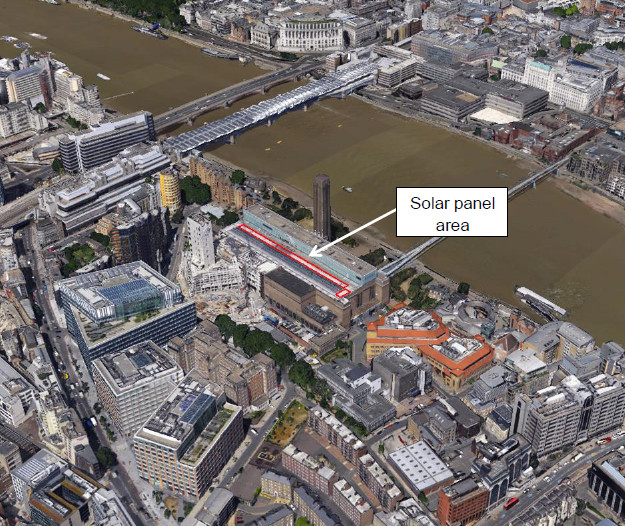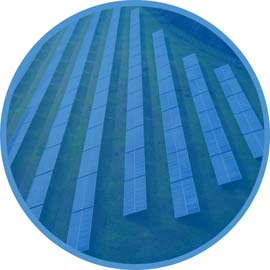Introduction
The Tate Modern is the world’s most popular museum of modern and contemporary art, attracting around 5 million visitors each year. The gallery is located in the former Bankside Power Station on the river Thames which last generated electricity in 1981.
In late 2015 the Tate Modern, in conjunction with Solarcentury, installed solar photovoltaic (PV) panels on the roof of the gallery with a capacity to generate approximately 82kWp of electricity. The solar system is designed to reduce the gallery’s grid electricity demand whilst contributing towards its wider sustainability agenda1.
Being under 1MW capacity, the PV development falls under Permitted Development rights2. The guidance states that a glint and glare assessment can be requested by a planning authority to support any PV application under 1MW. In this instance Southwark Council requested a glint and glare assessment.
Pager Power was subsequently approached by the Tate Modern and a glint and glare assessment was commissioned. The following case study outlines the approach taken to satisfy the council’s request.
Background
The solar panels were developed by Solarcentruy on behalf of the Tate Modern.
The Tate Modern is located in Bankside, central London. Specifically, the gallery is south of the River Thames and just south east of Blackfriars Station. The site location is shown in the figure below.
Pager Power was commissioned to undertake a study regarding glint and glare impacts in order to address the request by Southwark Council. The site location was initially reviewed to determine the scope of assessment required. The results showed that an assessment for residents in surrounding high-rise dwellings that may have a view of the solar panels was required.
The Challenge
Particular challenges associated with this project were:
- Modelling solar panels on a roof as opposed to ground mounts, with panels facing east, south and west.
- Identifying suitable receptors in a built-up urban environment where a view of the solar panels may exist.
The Process
The first step was to identify potential receptors of glint and glare. This was done by inspecting mapping and aerial photography of the surrounding environment. London City Airport is over 10km east and Heathrow is over 23km west of the Tate Modern, aviation issues were therefore ruled out. Road receptors were also ruled out because no road users would be able to view the solar panels on the rooftop. This left high-rise residential and office buildings. These were identified by reviewing 3D mapping of the area to determine the buildings that may have a potential view of the solar panels. In total, 22 receptors points were taken from several surrounding buildings for assessment.
Detailed analysis was then undertaken to determine whether solar reflections were geometrically possible and, if so, when these would occur. The modelling takes into account the relative heights of the panels and the receptors, the latitude and longitude at the panel location and the path of the Sun through the sky throughout the year.
Figure 2 shows one of the many Glint and Glare Charts that were produced within the report. This is one of multiple technical outputs from Pager Power’s bespoke model.
The overall impact significance was then determined based on the time and duration of any effect and the likely effect of direct sunlight. Conclusions were drawn based on the results of the modelling, published guidance / studies and professional judgement.
The Solution
The assessment demonstrated that a number of high-rise building developments would be completely unaffected by glint and glare.
However, it was shown that the solar panels orientated at various azimuth angles on the rooftop may produce reflections towards a small number of receptors under particular conditions.
Comparisons were made to existing reflective surfaces already present in the ambient environment such as the 524 glass panes on the roof of the Tate Modern and the 4,400 photovoltaic panels already present on the roof of Blackfriars Bridge. Consideration of the effects in the context of the available studies also showed that the issues were negligible in instances where a solar reflection was geometrically possible. The assessment therefore satisfied the planning authority’s concerns.
The Result
The Pager Power report was submitted to Southwark Council, which was subsequently accepted.
This development, although under Permitted Development, highlighted the importance of consultation with the council and knowledge of the appropriate guidance. A negative result could have meant installation of the solar panels was not permitted.
The solar panels have now been in operation since late 2015.

Figure 1: Tate Modern location

Figure 2: Glint and Glare Chart

Figure 3: Solar panels on the TATE Modern rooftop (Image courtesy of the TATE Modern)
How can we help you today?



THE SECTORS WE SERVE




